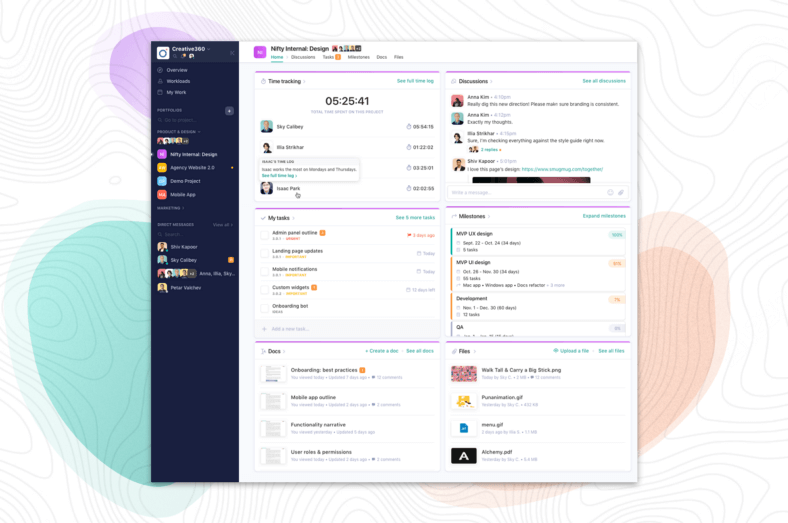
Project scope management sounds like one of those unnecessarily complicated terms productivity gurus coin to sound smart. Still, by the time you finish reading this post, you will realize why project scope management is so important, and how your team can benefit from defining a project scope statement today. We will also explain how Nifty can serve as a hub for your whole project, which will make it easy to keep things under control. Let’s begin!
What Is Project Scope?
Project scope breaks down all the work that you need to get done in order to deliver the project. It involves all the objectives, goals, and deliverables one project has and all the processes that are required to complete it.
Project scope defines goals, but also tasks and deliverables that are needed to achieve those goals. It also sets budgets, deadlines, and makes it clear what “success” is.
Project managers usually have the project scope written down in a statement of work document, also known as the project scope statement. Project managers return to this document often, as they want to make sure the project is on the right track at any given moment.
Project scope management defines what type of work is needed to complete the project, and it guarantees that the work done is the work that was required and was within the scope. Project (scope) manager ensures that the project stays within the budget and deadlines and that it also meets the needs of the end customer.
In short, defining the project scope is one of the most important things you can do to make sure the end result is a successful one. Without a clear project scope, you are leaving too much to chance, and even if you do achieve a somewhat good result, it will probably be with a lot of wasted resources.
Sticking To The Plan — Avoiding Project Scope Management Creep
The project scope statement is an essential document as it will ensure that the project stays on the right course. A project manager will make sure that every team member takes actions aligned with the project scope, in the most optimized way possible, without wasting resources.
The whole point of project scope management and the scope statement is to avoid scope creep. This term describes changes to the project scope that are made “on the go” and are not done deliberately and under control. These changes on their own often don’t seem significant, but they often have big consequences in terms of wasted resources, missed deadlines, and unhappy stakeholders.
Allowing The Right Kind Of Change
Having a clear scope statement and a project manager who monitors the process making sure all activities are leading the project in the right direction, will prevent scope creep. This is why it is essential to use tools that enable you to keep everything organized and in one place, rather than scattered across multiple apps that only serve one purpose.
But, it is important to say that project scope management won’t prevent changes. It will only prevent uncontrolled changes that don’t lead the project in the desired direction. If a change is necessary and keeps the project on course, a project manager will give it the green light.
In other words, the project scope shouldn’t be blindly followed to the letter, vetoing all changes. It is there to make sure that scope creep doesn’t derail the project. Although it is not set in stone, all the changes that are made to the initial project scope should still be aligned with its core. If that’s the case, then success is guaranteed at the end.
Important Steps In Defining A Project Scope Management Plan
- Collecting stakeholder requirements — before defining the scope, you need to reach out to all the stakeholders and ask them about the expectations they have from the project. The end result needs to satisfy all of them, so make sure you don’t miss anything important.
- Defining scope statement — the most important document in the scope management is the scope statement, which is why it makes sense to spend some time defining it. Therefore, it is good to go a bit more in-depth and be precise when describing the scope of the project. Of course, it still needs to leave some room for later adjustments, but it should be rigid enough to prevent most of the scope creep.
- Making a work breakdown structure and assigning roles — once you have the scope statement, you need to break the project down into smaller tasks and deliverables and assign all of those to the most appropriate teams or team members. Each task should have a budget, a fixed due date, or at least a time estimate. That way, the project will stay within the schedule, and every person will know what resources are available to them, and when the deadlines are. Nifty does a great job here as it lets you create milestones, assign tasks with subtasks, which are all connected and lead to project completion once checked, and you can visually see the progress. This way, no room is left for scope creep, as you can see how every action impacts the project progress.
- Checking with stakeholders and making changes where needed — once the deliverables are complete, you should check with stakeholders (or customers) if they are satisfied with the result. Sometimes, they will request a significant change that will alter the whole scope (which is different from scope creep). You will have to manage the modification, which can result in project management plan updates, project document updates, or other organizational or work changes. However, all of those still need to be centered around the original project scope, and never go against it.
Nifty — The Only Tool You Need To Keep Your Project Scope Management On Track To Success

As you can see, the project scope is beyond important, and defining it right can make or break the whole project. Because the project scope statement is such a vital document, you will often get back to it, which is why it makes a lot of sense to have it at hand all the time.
Nifty not only allows you to assign tasks to your team members, but also to communicate with them, share files, and monitor the whole project progress. Also, because it has unique Nifty Docs, you will be able to have your project statement right in the project management app itself, available to everyone on the team. That will make sure all team members are aware of the requirements and their responsibilities, which will keep the project heading in the right direction. And, if you are a fan of Google Docs, and would use it instead of Nifty Docs, no worries — there’s a built-in Google Docs integration, which will let you use your favorite writing tool right within the Nifty interface.
Because Nifty is a one-stop-shop for your whole project, you will be able to work much faster, as your project won’t be scattered around a dozen unnecessary tools. Everything will stay in one place, and Nifty will never stand in the way of your productivity but push it to a new level.
Try Nifty for free today and build out your project scope with the utmost clarity! 🚀







